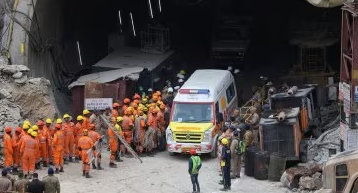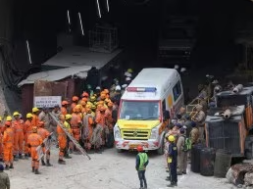
Manas Dasgupta
NEW DELHI, Nov 28: So near and yet so far! The rescue operators to extricate 41 workers trapped in the collapsed tunnel in Uttarakhand for the last 17 days is claimed to have achieved the “breakthrough” but are still to shake hands with the hapless workers.
The authorities have kept claiming for the last several hours that only two metres are left between the trapped workers and final freedom but as the clock kept ticking, the officials kept changing the deadlines for final completion of the rescue operation. While initially the authorities expected to begin bringing out the stretched labourers one by one from 3 P.M. onwards, was later revised to “over-night operation.”
“We are in no hurry. We also have to take care of the safety and security of people who are rescuing the workers,” Lieutenant General Syed Ata Hasnain (retd.), a member of the National Disaster Management Authority, said Tuesday. He said all safety precautions would be implemented, and that the rescue operations would not be hurried unnecessarily. He also refused to give any “premature announcements” [regarding the trapped workers] as it would be against all principles. He said the operation may take “the entire night” but prep to receive the workers, including providing them with medical aid, was ready.
Rescue teams are clearing the final few metres of debris – thanks to the banned manual “rat-hole”-mining technique employed after high-tech machines, or augers, failed to drill the necessary 60 metres – and lay two-feet wide pipes to create an escape route.
“We are near a breakthrough… but not yet there. Manual work has carried on the entire night and we have reached 58 metres (thanks to) our ‘rat miners’ and Army engineers. The trapped workers inside have said they can hear noises of work being done…” Lt General Hasnain explained. The Air Force has stationed a Chinook helicopter (a twin-rotor heavy-lift chopper) near the medical centre at Chinyalisaur, to which the trapped men will be taken once they are brought out of the tunnel.
Earlier during the day, the Uttarakhand Chief Minister Pushkar Dhami said “the work of laying pipes” had been completed. “As a result of immense grace of Baba Baukh Nagji (and) prayers of crores of countrymen and the tireless work of all rescue teams… the work of laying pipes in the tunnel to take out the workers has been completed. Soon all the labourer brothers will be taken out,” he said on X.
Officials said National Disaster Response Force (NDRF) and emergency medical personnel with stretchers have taken over the rescue op, and have begun to work their way into the collapsed cavern. Visuals from the rescue site – a storm of activity as battalions of tunnelling experts, disaster response teams and medical personnel are at work – showed ambulances – one for each trapped man – being taken, one-by-one, into and out of the tunnel. These were understood be practice drills for when the workers are finally brought above ground.
NDRF personnel are expected to enter the steel chute pushed into the drilled passage over the past several days and then bring out the workers one-by-one. Going by the practised drill, each worker will lie down on a wheeled stretcher that would be pulled by rescue workers outside using ropes. This is expected to take about two or three hours.
At the disaster site the mood was upbeat over the imminent end of the multi-agency rescue operation. An eight-bed makeshift health centre was set up inside the tunnel to provide immediate medical care to the workers after their evacuation. Ambulances had lined up at the mouth of the tunnel to rush the rescued workers to the community health centre about 30 kilometres away, after the initial check-up at the site.
The medical facility has 41 oxygen-equipped beds and the necessary equipment and medicines to provide each worker with the required medical care. “Rescued workers will be brought here only if medical treatment cannot be met in district hospital. At AIIMS Rishikesh, there are 20 beds in Trauma Centre and a few in the ICU,” a senior physician said.
Earlier today relatives were asked to “be prepared”; “Keep their clothes and bags ready,” officials told them, explaining that one family member would be allowed to ride in each ambulance.
The final stretch of the rescue process has been completed not by the expensive drillers, or augers, like the 25-ton machine that broke down Monday, but by a manual system called “rat-hole” mining, which was banned in 2014 for being unscientific and causing increased environmental pollution.
Efforts till now have included smaller pipes being pushed through nearly 60 metres of debris to provide food, drinking water and medicines. The food supplied so far – in consultation with doctors and dieticians – has included khichdi and fruits, as well as pulao and mater paneer. The smaller pipes have also been used to maintain communication with the workers; this includes the use of landlines that are used twice daily to allow the men to speak to anxious family members.
The work of construction of the Silkyara tunnel was started four years ago to decrease the distance from 28 kilometres to 4.5 kilometres between Gangotri and Yamunotri, as part of the Char Dham project. The ₹12,000 crore project was announced on December 23, 2016. It aims at broadening the roads of about 900 km of national highways for safer, smoother and faster traffic movement. They connect the holy shrines in Uttarakhand: Yamunotri, Gangotri, Kedarnath and Badrinath. The project also includes the Tanakpur-Pithoragarh stretch of the Kailash Mansarovar Yatra route.














